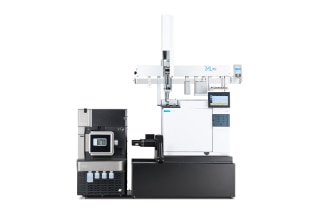Waters Atmospheric Pressure Gas Chromatography (APGC) Source
Discover the benefits that the next generation GC-MS source can offer your laboratory for both routine and research applications in terms of operational efficiency, cost savings, and analytical quality across a range of MS technology platforms.
Atmospheric Pressure Gas Chromatography (APGC) source technology offers a powerful alternative to electron ionization (EI) for gas chromatography coupled with mass spectrometry (GC-MS). The Waters APGC source provides atmospheric pressure ionization for increased selectivity, sensitivity, and confidence in analyte identification – so your lab can overcome many of the typical limitations of vacuum-based systems.
Overview
- Provides increased selectivity and confidence in compound identification and confirmation for both discovery and targeted workflows
- Achieve ultimate sensitivity with Waters tandem quadrupole mass spectrometers, enabling the lowest limits of detection to meet the most demanding regulatory requirements
- Utilize high sensitivity to streamline sample preparation and/or employ injection modes that reduce matrix load on column, thus reducing system maintenance
- Discover the benefits of higher source operating pressures, which allow flexibility in terms of carrier gas flows, no compromise chromatography, and more sustainable operation
- Build flexibility and capability into your lab with an MS system that can easily be configured for either GC-MS or LC-MS use depending on project needs
- Allows for the use of nitrogen as GC carrier gas without negative impact to the separation and the sensitivity
Recommended Use: For quantification at ultra-trace levels in complex samples and providing comprehensive data for screening, discovery, and characterization workflows.
Features Header
Outstanding performance for GC-MS/MS trace quantification
The APGC source takes advantage of soft, atmospheric pressure chemical ionization. Soft ionization means that for most analytes high abundance molecular ions and reduced fragmentation are generated in contrast to the highly fragmented spectra commonly observed using electron ionization (EI).
Soft ionization simplifies the selection of high abundance, higher mass precursor ions in MS/MS analysis, which enables the APGC source to provide increased selectivity, sensitivity, and confidence in analyte identification. This is especially important for quantification of analytes at low levels in complex matrices where analytes and / or co-extractives may have similar fragment ions.
Waters universal source architecture enables the APGC source to be installed on all Waters Xevo tandem quadrupole MS systems to deliver the highest quantitative performance for GC-MS/MS.
Sensitivity drives productivity in GC-MS/MS workflow and lab operations
The sensitivity gain achieved by using the APGC source can drive lab productivity and save costs by allowing for more flexible and preferred injection techniques providing more robust operation. With the sensitivity of the APGC source, your lab can:
- Use lower injection volumes to reduce the absolute matrix load on the analytical column. This can help to reduce the cost of instrument consumables and the time and cost associated with instrument maintenance
- Make use of split injection mode to reduce residence time in the GC injection port and improve method performance and overcome challenges with analyte stability
- Streamlined sample preparation, for example avoiding time consuming and manual concentration, evaporation and/or solvent exchange steps, while still achieving your required reporting limits
Increased flexibility for GC-MS methods
No compromise GC-MS
With the APGC source operating at atmospheric pressure, many limitations experienced in vacuum-based systems can be overcome. Higher source operating pressures allow great flexibility in terms of carrier gas flows and column sizes that can be used for GC/MS without compromises imposed by a vacuum-based source. For example running split injections at higher carrier gas flows can provide reduced runtimes and up to 200% increase in throughput whilst conserving carrier gas use and maintaining method performance.
Unrestricted use of nitrogen carrier gas
With volatility in helium supplies impacting availability and cost, laboratories continue to explore alternatives to future proof their operation and continuity of service. Operating the GC source at atmospheric pressure enables the use of nitrogen as a carrier gas, without certain limitations experienced in vacuum-based GC systems. The unrestricted use of nitrogen with the APGC source enables laboratories to:
- Maintain method performance and transfer methods easily to nitrogen use
- Ensure continuity of service, reducing dependence on helium supplies
- Better manage costs with access to a more sustainable gas supply
